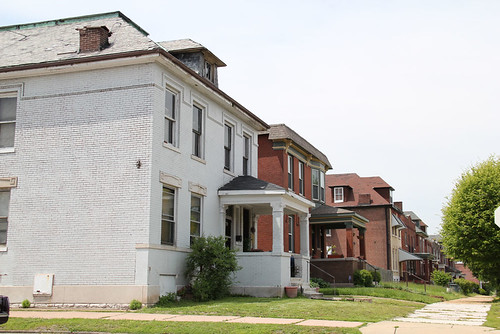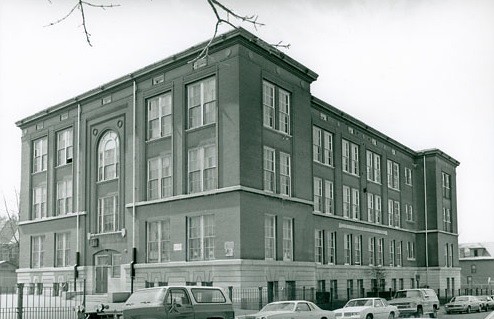by Michael R. Allen

Wednesday was a sobering day for historic preservation in St. Louis. Very early Wednesday the Missouri Senate perfected a bill (SCS SB120, passed n voice vote) that would reduce the cap on historic tax credits from $140 million to $45 million, while imposing a $5 million cap on “small” projects. Small projects are defined as those with costs of 1.1 million or less — which is about 55% of projects but last year only about $10 million in allocations. The majority of members of the Missouri Senate would slow down both large and small projects. Some senators aren’t doing this to balance the budget or better focus job creation, because they spent yesterday debating a bill for a giant tax cut. The Missouri House seems to be headed toward a more modest cut inn historic tax credits, while Governor Jay Nixon’s current stance is evanescent.
Later, back in St. Louis, St. Louis Public Schools Superintendent Kelvin Adams announced the need for more school closures. Adams’ closure list: Sherman Elementary, L’Ouverture Middle School, Fresh Start South, Multiple Pathways Alternative, and Cleveland NJROTC. Some of these are in historic buildings. I live a few blocks away from Sherman Elementary School, a stately red brick placemark in the Shaw neighborhood. Completed in 1898, the Classical Revival building is among the earliest schools by master designer William B. Ittner. Yet most important in my neighborhood is that it is our public elementary school. Some of us send students there, while others perhaps dream of sending our children a few blocks to that school, in the neighborhood.

Of course, only the most wistful urbanite assumes that dreams are enough to keep a school district going in a city that lost 29,000 residents between the last two Census counts. And few of my peers dream of sending their children to public schools like Sherman. Progressive charter schools are more likely, but resource-right suburban schools are even likelier. Until that changes, and the city’s population rises, schools like Sherman will be at risk of closing.
Yet we cannot just throw our hands up bemoaning demographic shifts or social divisions that lead to school closings. While we work to improve the public school system, we also must work to make sure that schools buildings like Sherman don’t become black holes in our neighborhoods. A recent working paper from the Cleveland Federal Reserve Bank shows that vacant property depresses adjacent property values by as much as 9.4%. Vacant lots can be as troubling as vacant buildings, so the notion that “surplus” buildings like Shaw can be wrecked — as with Hodgen School last year — won’t really bring net benefits to city neighborhoods.
Again, we could throw our hands up. Vacancy is a giant problem, and if demolition won’t fix it then we may seem stuck. That is exactly where redevelopment tax credits come into play. These are tools that prevent vacancy from terrorizing neighborhoods and cities, all across Missouri. St. Louis is just in the throes of bigger physical changes wrought by demographic shifts as many small towns face. Drastically cutting the state historic tax credit while cities and towns are still dealing with school closures and vacant Main Street storefronts seems like a risk.
The debate over incentives often isolates issues like the fate of Sherman School to St. Louis. St. Louis’ representatives are vocal opponents of changes, while many from other parts of the state support it. Yet Sherman School going vacant impacts property values in Shaw, which impacts valuation across St. Louis, which impacts the metropolitan area, which tarnishes Missouri as a whole. St. Louis complains about the rest of the state, but in its postindustrialized condition needs the goods and services coming from smaller Missouri cities. Blight is not a local problem, it’s a state problem. Fighting blight is an investment in jobs, property values, tax revenue and an improved state image.
Right now, Missouri has a reputation as being smart enough to see how school closures in St. Louis are linked to overall state prosperity. Our historic tax credit is a national model, and its economic impact has been shown to outpace the US GDP. Senators complained Wednesday about Missouri ranking last in many things, but first nationally in historic tax credit allocations. From the sound of the discussion, one would have thought they were governing a state that had solved its vacant property problems. As the impending St. Louis school closures make clear, that is not so.


4 replies on “Missouri Has Historic Tax Credits For a Reason”
Is there any hope of stopping this bill? I made quite a few calls to state senators about this and it is demoralizing that they would give a voice vote.
This makes no sense to me. Sherman is an “updated” school with AC and functioning facilities and is OWNED by the district, yet they lease the Imagine ES& M building just blocks away? Adding kids to the classroom will not improve test scores for a district that looks to contnue their accredidation. I realize that the amount of kids housed at Imagine ES & M is 1200+ and elementary schools range in the 3-500 student range. Wouldn’t using their existing building stock vs. leasing a building be of greater benefit to the school district??
You make good points. There also is the future implication of closing Sherman. Once it is closed and sold, it won’t likely return to use when the city finds itself in better shape.
I think that the House will block these cuts, but will probably agree to slightly higher ones. Rep. Anne Zerr has introduced HB698 that would impose a $120M cap, which is a good number but one likely to meet Senate objection. I’d contact House members and urge them to stand strong, and make sure that Governor Nixon knows how you feel.